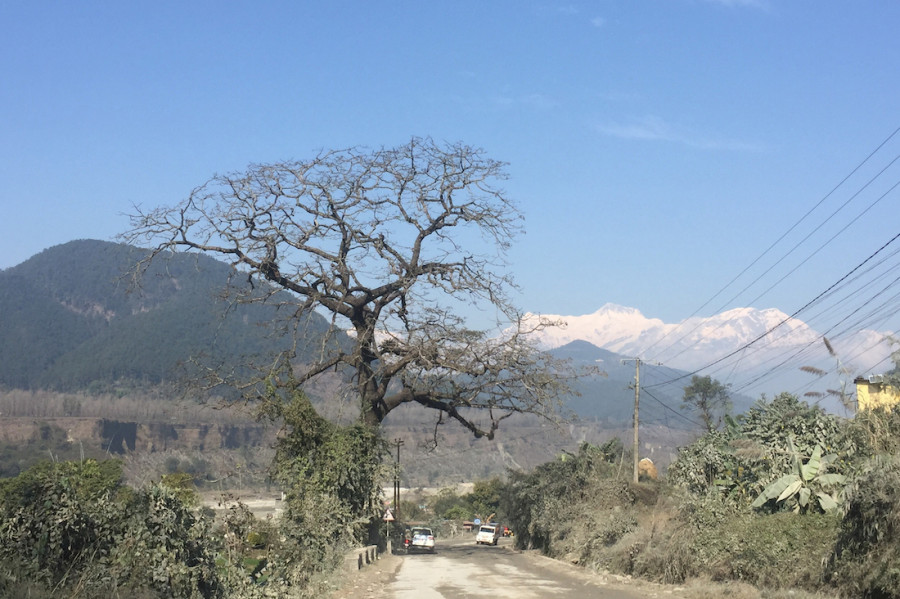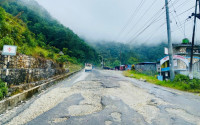Gandaki Province
Officials snub calls to save egg of endangered vulture
A roadside tree in Shuklagandaki Municipality where a pair of slender-billed vultures had built nest and laid an egg has been felled for widening the road.
Deepak Pariyar
Hemanta Dhakal—a bird conservationist and researcher affiliated with the International Union for Conservation of Nature—often visited Shuklagandaki of Tanahun district from Pokhara on Saturdays to inspect and study slender-billed vulture, locally called Sano Khairo Gidda.
A pair of vultures had built a nest on a roadside kapok tree in Shuklagandaki Municipality-2 along Prithvi Highway and laid an egg there. It was an opportunity for Dhakal to study the activities of the slender-billed vultures, a critically endangered bird species in Nepal. He was happy to see the vultures and the egg that would certainly help to increase its population. However, the conservationist’s dream to watch fledgling flying in the sky evaporated as the kapok tree (Bombax ceiba) was felled on February 1 to widen the road.
The road widening work of the Muglin-Pokhara section of Prithvi Highway is underway with loan from the Asian Development Bank. Around 8,000 trees are to be cut down along the section to make way for a four-lane road. The construction company initiated cutting down trees with permission from the Department of Forests and Soil Conservation. The conservationists urged the authorities concerned not to cut down the kapok tree until the slender-billed vulture’s egg hatched and the fledgling flew.
Pokhara Bird Society formally wrote a letter to Shuklagandaki Municipality last month, urging the local unit to coordinate with the Department of Roads to not fell the tree for a few more weeks by explaining the importance of vulture conservation. The municipality also verbally informed Ward 2 representatives about the matter. The society also submitted a memorandum to the Division Road Office in Damauli.
However, ignoring the conservationists’ request, Yanhui Kaiyun Highway and Bridge Construction, the Chinese construction company that won the contract, cut down the tree with the nest and egg of the critically endangered vulture.
The bird conservationists have expressed their concerns that the authorities blatantly ignored the issue of conservation while carrying out the construction project. They termed the incident of tree felling and destroying the egg of the critically endangered species ignoring their pleas as ‘foetus killing’.
Manshant Ghimire, chairman of Pokhara Bird Society, says the incident not only highlights the construction company’s and the stakeholders’ ignorance of conservation issues but also brings humanity into question.
“Destroying the nest with the egg is akin to foetus killing of nature’s cleaners. The construction company could have waited for about two months to cut down the tree as per our request. It is a shameful act for the world conservation community,” said Ghimire.
“While building the development infrastructure, there is a general practice the world over that such activities should be stopped if the birds and other animals in the area are in the stage of reproduction. But here nobody cares about such sentiments,” he claimed.
According to Ghimire, Shuklagandaki's incident is just a case in point. Similar incidents go unchecked in other areas as well but they are either unnoticed or go unreported, he added.

Nine vulture species are recorded in Nepal. Four of them—white-rumped vulture, slender-billed vulture, red-headed vulture and Indian vulture—are listed as critically endangered. The Egyptian vulture is listed as endangered and three species—bearded vulture, cinereous vulture and Himalayan griffon—are listed as near threatened.
According to Dhakal, who has been studying slender-billed vultures since 2018, there are around 50 to 75 vultures of this species in the country. He said the vulture species lay a single egg in one reproduction season. “Four nests of this vulture species are recorded in various parts of the country this season. One of the nests was in the roadside kapok tree at the Gachhepani area of Shuklagandaki Municipality. The slender-billed vulture laid an egg, hatched it, and brought up a fledgling in the same tree last year,” said Dhakal. According to him, felling the tree by destroying the egg is a serious offence in the field of conservation.
According to Dhakal, the nests of slender-billed vultures are spotted in Gachhepani of Tanahun, Dobilla of Kaski, Dang and Shuklaphanta National Park in Kanchanpur this season. This vulture generally starts building nests in the months of October-November and lays eggs in November-December. The egg is hatched in around 45 to 55 days.
Dhakal had been frequently visiting the Gachhepani area since he spotted the nest in December.
Kisan Gurung, mayor of Shuklagandaki Municipality, had agreed with the request of Pokhara Bird Society and assured to coordinate with the relevant authorities to not cut down the kapok tree until the vulture would grow its fledgling. But the tree was felled as Gurung failed to coordinate with the Department of Roads and the construction company on time on the matter.
The Post tried to reach Gurung for comment but he did not receive phone calls.
“The forest department and the division road office have been shrugging off the issue saying that they weren’t aware of birds nesting on that tree since it was not brought to their notice,” said Dhakal.
The construction company cut down around 2,200 trees in Tanahun as of now.
Mohan KC, the assistant residential engineer at the company, said that he was unaware of the conservationists’ request to protect the tree for about two months. “We could have left the tree alone for about two months. But we did not know about the vulture’s nest on the tree and the relevant authorities did not inform us about it,” said KC.
Several species of vultures have been spotted in various parts of Tanahun district lately. Vulture population increased in the area as Byas Municipality set up a Cow Conservation Centre, locally known as Gaushala, on the banks of the Madi river four years ago to manage stray quadrupeds. Old and diseased cows and other animals die often and the vultures visit the area to eat the carcasses.
However, Bhorletar-Damauli 33 KV transmission line of Midim Hydropower Project at Shisuwa Bhateri area in Byas has been the death trap for vultures lately. Around 100 vultures, according to the conservationists, were electrocuted while the vultures attempted to perch on the electricity pole of the transmission line.
There are several challenges in conserving the country’s vultures. Climate change, shrinking habitats, increasing use of harmful veterinary drugs by farmers and lack of food are among the major threats to vulture conservation.




 5.4°C Kathmandu
5.4°C Kathmandu.jpg)








%20(1).jpg&w=300&height=200)

